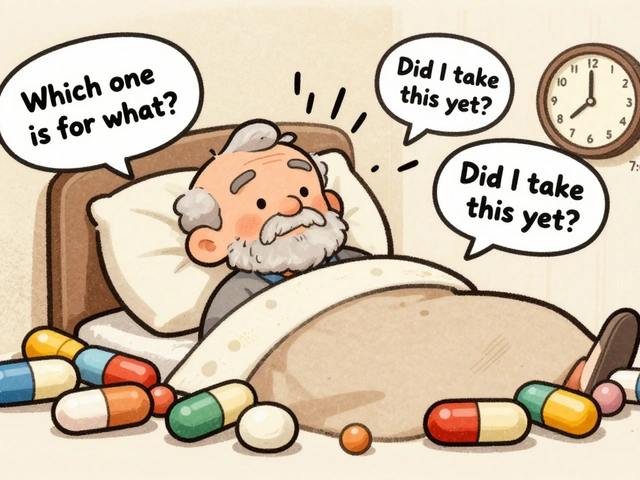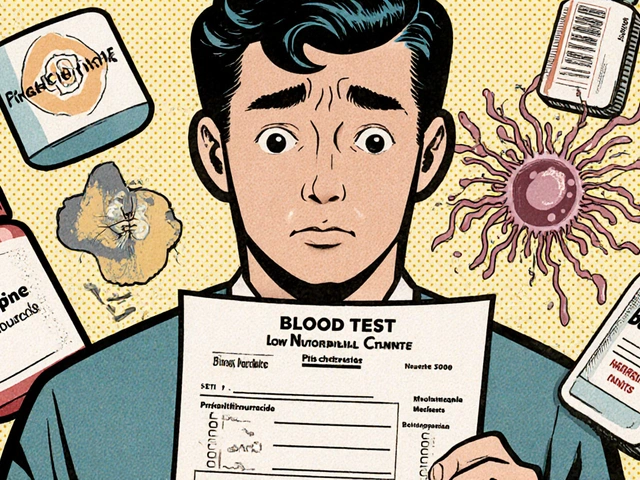Constipation isn’t just uncomfortable-it can be exhausting, embarrassing, and disruptive to daily life. About 1 in 6 adults deals with it regularly, and that number jumps to 1 in 3 for people over 60. You don’t need a prescription to find relief, but not all over-the-counter (OTC) options work the same way. Some are gentle and safe for daily use. Others can do more harm than good if used the wrong way. Knowing the difference between fiber, stool softeners, and laxatives can save you from wasted money, side effects, and even serious health risks.
Fiber Supplements: The Gentle Start
Fiber is the first line of defense for most doctors. It’s not a drug-it’s food. Bulk-forming laxatives like psyllium (Metamucil, Citrucel) absorb water in your gut and swell into a soft, bulky mass that pushes stool through naturally. This mimics how your body should work when you eat enough vegetables, fruits, and whole grains.
But here’s the catch: fiber doesn’t work without water. If you take psyllium without drinking enough, it can actually make constipation worse-or worse, cause a blockage. You need at least 8 ounces of water with each dose, and ideally 64 ounces total per day. Start slow: 5 grams a day for a week, then increase to 25-30 grams. Jumping to a full dose too fast? You’ll get bloating, gas, and maybe even pain.
Studies show fiber works for about 55% of people with chronic constipation, compared to 35% on placebo. It’s not the fastest fix-takes 12 to 72 hours-but it’s the safest for long-term use. And unlike pills, fiber doesn’t train your bowels to rely on stimulation. It just helps them work the way they’re supposed to.
Stool Softeners: Often Overhyped
Docusate sodium (Colace) is one of the most popular OTC remedies. It’s marketed as a “gentle” solution that helps stool retain water so it’s easier to pass. Sounds perfect, right? But here’s the truth: clinical trials show it’s barely better than a placebo.
A 2021 meta-analysis found docusate sodium was only 15% more effective than no treatment at all. In user reviews on WebMD, 62% of people said it had “minimal to no effect.” That’s why experts like Dr. Eamonn Quigley say it shouldn’t be used alone for treating constipation. It’s fine as a helper-for example, if you’re recovering from surgery and need to avoid straining-but don’t count on it to fix chronic issues.
It also takes 12 to 72 hours to work. If you’re desperate for relief, this isn’t your go-to. And while it’s low-risk for side effects, it’s not worth the money if you’re not pairing it with something that actually moves things along.
Osmotic Laxatives: The Gold Standard
If fiber doesn’t cut it, the next step is osmotic laxatives. These pull water into your colon like a sponge, softening stool and triggering natural bowel movements. The most proven option? Polyethylene glycol (PEG), sold as MiraLax or generic equivalents.
Here’s why it’s the top choice: in 41 clinical trials involving over 6,800 patients, PEG worked for 70-80% of people with chronic constipation. That’s way higher than stool softeners, stimulant laxatives, or even lactulose. It’s also safe for daily use-up to six months in studies-with only 15-20% reporting mild side effects like bloating or gas. Compare that to stimulant laxatives, where up to 30% report cramping.
How to use it: one 17-gram packet dissolved in 4 to 8 ounces of water, once a day. Works in 1 to 3 days. No urgency. No cramps. No jitters. Just steady relief. Many users on Reddit say it’s the only thing that gave them consistent results without side effects. Amazon reviews for MiraLax sit at 4.5 out of 5 stars from nearly 30,000 reviews.
And cost? Around $12-$22 for a 30-day supply. That’s a fraction of prescription alternatives that can run $160 a month. The FDA even approved a new version, MiraLax Plus, with added electrolytes in 2023 to help prevent dehydration-a smart upgrade.

Stimulant Laxatives: Fast, But Risky
Bisacodyl (Dulcolax) and senna (Ex-Lax) work by directly stimulating the nerves in your colon to contract. They’re fast-often working in 6 to 12 hours. That’s why people reach for them when they need relief now.
But here’s the problem: they’re not meant for regular use. Using them more than once a week for more than a week can lead to “cathartic colon”-a condition where your colon becomes dependent on stimulation and loses its natural ability to contract. Studies show 15-20% of chronic users develop this. And side effects? Cramping, nausea, and electrolyte imbalances are common. About 25-30% of users report abdominal pain.
On Amazon, Dulcolax has a 4.1-star rating, but the negative reviews are loud: “Intense cramps,” “felt like I was going to pass out,” “emergency bathroom rush.” That’s not gentle relief-that’s a gut punch.
Doctors give stimulant laxatives a “Grade A” recommendation-but only for short-term use. Think: one or two doses after surgery, or after opioid painkillers. Not for daily constipation. If you’ve been using Dulcolax or Ex-Lax every week for months, you’re risking long-term damage.
Saline Laxatives: Quick Fix, Big Risk
Milk of Magnesia and magnesium citrate are saline laxatives. They work fast-sometimes in under an hour. That’s why people use them before travel or after heavy meals.
But they’re dangerous if used regularly. Magnesium draws water into the intestines aggressively. Too much, too often, and you risk dehydration, low potassium, or even heart rhythm problems. The Mayo Clinic warns against daily use. Most users don’t realize they’re doing something risky because it works so quickly.
It’s fine for occasional use. But if you’re using it more than once a week, you need to talk to a doctor. It’s not a solution-it’s a band-aid on a broken system.
What Works Best? The Real-World Algorithm
Here’s what most doctors actually recommend, based on guidelines from the American Gastroenterological Association and the Cleveland Clinic:
- Start with fiber. Aim for 25-30 grams a day from food or supplements. Give it 2 weeks. Drink water.
- If fiber fails, switch to PEG (MiraLax). One dose daily. No need to time it-take it after dinner for morning results.
- If you still aren’t moving, try a stimulant laxative once. Use bisacodyl or senna for rescue only. Never more than 3 days in a row.
- Avoid stool softeners alone. They don’t work well by themselves.
- Avoid saline laxatives daily. They’re for emergencies, not maintenance.
And here’s a tip from real users: don’t double up. Don’t take fiber + PEG + Dulcolax. That’s how you end up in the ER with cramps and dehydration. Pick one. Stick with it. Let your body adjust.

When to See a Doctor
OTC remedies are great-but they’re not magic. If you haven’t had a bowel movement in 7 days despite using the right treatment, stop and call your doctor. Same if you notice blood in stool, unexplained weight loss, vomiting, or severe pain. These aren’t signs of simple constipation. They could mean something more serious.
Also, if you’re on opioids, have diabetes, kidney disease, or are over 65, talk to your doctor before starting any new OTC remedy. Your body handles these differently.
What’s Changing in 2025?
The OTC constipation market is growing fast, hitting $1.2 billion in the U.S. alone. But the biggest shift? PEG is taking over. It’s no longer just a backup-it’s the new first-line standard. New formulations with electrolytes are rolling out. And by 2025, we’ll likely see the first OTC products targeting the gut microbiome, with early trials showing 15-20% better results than PEG alone.
Meanwhile, stimulant laxatives are under review. The FDA is expected to update labeling by 2025 to include stronger warnings about long-term use. That means even more clarity for consumers: don’t rely on Dulcolax every week.
Final Takeaway
You don’t need to suffer through constipation. But you do need to choose the right tool. Fiber is the foundation. PEG is the most effective, safest long-term fix. Stimulant laxatives? Save them for emergencies. Stool softeners? Don’t waste your money unless you’re in recovery. And always, always drink water.
Constipation isn’t something to ignore. But with the right OTC remedy-and the right habits-it’s something you can manage without a prescription, without fear, and without pain.
What’s the safest OTC laxative for daily use?
Polyethylene glycol (PEG), like MiraLax or its generic versions, is the safest for daily use. Clinical studies show it works for 70-80% of people with chronic constipation and has minimal side effects when used as directed. It doesn’t irritate the colon or cause dependency. Most doctors recommend it as the first-line treatment over fiber, stool softeners, or stimulant laxatives.
Can I take fiber and MiraLax together?
Yes, but only if you’re drinking enough water. Fiber needs water to work, and MiraLax pulls water into the colon. Taking them together can help, but if you don’t hydrate properly, you risk bloating or even blockage. Start with fiber first. If after two weeks you’re still stuck, add MiraLax. Don’t start both at once.
Why doesn’t Colace work for most people?
Colace (docusate sodium) only helps stool retain water-it doesn’t stimulate movement. In clinical trials, it was only 15% more effective than a placebo. For people with slow transit constipation (the most common type), it does almost nothing. It’s useful for preventing straining after surgery, but not for treating actual constipation. If you’re using it alone and not seeing results, you’re not alone-most users report little to no benefit.
How long is too long to use Dulcolax?
Never use Dulcolax (bisacodyl) for more than 7 days in a row. Regular use can damage your colon’s natural ability to contract, leading to a condition called cathartic colon. This makes constipation worse over time. It’s meant for occasional relief, like after surgery or opioid use. If you need it more than once a week, talk to your doctor-you likely need a safer long-term solution like PEG.
Is MiraLax safe for seniors?
Yes, MiraLax is considered one of the safest options for older adults. It’s not absorbed into the bloodstream, so it doesn’t affect kidneys, heart, or electrolytes like magnesium-based laxatives can. The American Gastroenterological Association specifically recommends PEG for seniors with chronic constipation. Just make sure they’re drinking enough fluids-dehydration is a bigger risk in older adults.
Can OTC constipation remedies cause dependency?
Fiber and osmotic laxatives like MiraLax do not cause dependency. Your body doesn’t get used to them. But stimulant laxatives like Dulcolax and senna can. Over time, your colon stops responding to natural signals and needs the drug to move. This is called cathartic colon. It’s rare with proper use, but common among people who use stimulants daily for months or years. Stick to PEG or fiber if you need ongoing relief.
What’s the fastest way to get relief from constipation?
The fastest OTC option is a bisacodyl suppository-it can work in 15 to 60 minutes. Oral bisacodyl (Dulcolax tablets) takes 6-12 hours. Magnesium citrate can work in under an hour. But speed comes with risk: cramping, urgency, and dehydration. For most people, the best approach is patience. MiraLax takes 1-3 days but gives gentle, reliable relief without side effects. Don’t chase speed-chase safety.










The pharmacokinetics of osmotic agents like PEG fundamentally alter colonic homeostasis by creating an osmotic gradient that draws water into the lumen-this is not merely ‘softening stool’ but a physiologically elegant modulation of fluid dynamics. The clinical superiority of PEG over stimulants isn’t anecdotal; it’s evidenced by meta-analyses demonstrating sustained efficacy without downregulation of enteric neurotransmission. We’re not talking about a ‘laxative’-we’re talking about a homeostatic buffer.
Meanwhile, the continued proliferation of docusate as a first-line intervention speaks to a systemic failure in medical education. It’s a placebo with a brand name. The FDA’s 2025 labeling revisions will likely mandate disclaimers about its negligible effect size. Until then, we’re just perpetuating a cultural myth wrapped in pharmacy packaging.
I’ve tried everything. Fiber gave me bloating that felt like I’d swallowed a balloon. MiraLax? Worked-kinda. But I had to drink a gallon of water a day just to make it work. Is that really sustainable? I’m not a camel. And I’m 58. My kidneys aren’t what they used to be. I just want to go without feeling like I’m doing a science experiment on my own gut.
Just a quick note: if you’re using fiber, please, please, PLEASE drink water. Like, actual water. Not coffee. Not soda. Not that weird electrolyte drink your cousin swears by. Water. Eight ounces per dose. Minimum. I once saw someone take three tablespoons of psyllium with a sip of tea… and end up in the ER with a bowel obstruction. It’s not a joke. It’s physics. And your colon isn’t a magic box.
Also, MiraLax is not a miracle. It’s a tool. Use it wisely. And if you’re taking it for more than six weeks without seeing a doctor? You’re not being proactive-you’re being reckless.
Of course the FDA is pushing PEG. They’re in bed with Big Pharma. MiraLax is a billion-dollar product. Meanwhile, natural solutions like flaxseed, prune juice, and squatting are ignored because they can’t be patented. You think this is about health? It’s about profit. And you’re being manipulated into buying a $20 bottle of glycol instead of eating an apple.
Also, ‘25-30 grams of fiber’? That’s a joke. You’d need to eat three pounds of broccoli a day. Who has time for that? The system is rigged.
Anyone else just take Dulcolax when they need to go and call it a day? I’ve been doing it for years. Yeah I get cramps but so what? My gut doesn’t work without it. I’m not gonna eat salad all day. Life’s too short. If my colon wants to rebel? Fine. I’ll just give it a little push. Who cares if it’s ‘dependency’? I’m not dying. I’m just pooping.
Let’s be real-this whole article is corporate propaganda. MiraLax? That’s just antifreeze with a label. The FDA approves everything as long as the company pays enough. And don’t even get me started on fiber. You think your grandma’s oatmeal is gonna fix your colon? Nah. You need a colon cleanse. Or better yet-get off the grid. Eat meat. Stop eating ‘whole grains.’ That’s what’s really clogging you up. The system is poisoned.
Also, I saw a guy on TikTok who did a 7-day lemon water fast and pooped like a champ. No pills. No nonsense. Just lemons. Maybe we’re all just dehydrated and overprocessed.
How delightful that we’ve elevated bowel movements to a bioethical debate. We’ve turned constipation into a lifestyle product, complete with FDA-approved formulations, Amazon reviews, and influencer endorsements. How very 21st century. The real tragedy isn’t the laxatives-it’s that we’ve lost the ability to sit quietly, breathe, and let nature take its course. We’ve outsourced our biology to a 17-gram packet of polyethylene glycol. And we call it progress.
Bro I tried MiraLax after reading this and wow. Game changer. But honestly? The real MVP was drinking water while sitting on the toilet like a human and not scrolling TikTok. Also, I started eating dates. Like, 3 a day. No joke. They taste like candy and my gut loves it. No pills needed. Just food. Who knew? 🙌
This whole post is a liberal brainwash. Fiber? From ‘whole grains’? That’s the same junk that’s making everyone diabetic. You think the government wants you to be healthy? They want you dependent. On pills. On doctors. On their system. MiraLax is just another way to keep you docile. Real men use prune juice. Real women eat raw garlic. Stop buying into this pharmaceutical fantasy.
While I appreciate the comprehensive nature of this exposition, I must respectfully submit that the conflation of efficacy with convenience may inadvertently undermine the foundational principles of physiological autonomy. The recommendation of PEG as a first-line intervention, while statistically supported, may inadvertently promote a paradigm of pharmacological dependency, even in the absence of overt tolerance. A return to dietary modulation, coupled with mindful hydration and circadian rhythm alignment, remains the most ethically and biologically congruent approach.
Bro MiraLax saved my life 🙏 I was stuck for 10 days. No joke. I thought I was gonna die. Took one packet. Pooped like a champ the next day. Now I take it once a week just to stay chill. Fiber? Nah. Too much work. Water? I drink it. Done. 🤙
How quaint. A 1.2 billion dollar market for ‘constipation relief’-as if our modern, sedentary, sugar-laden, screen-saturated existence could be remedied by a $12 powder. We’ve turned the human digestive system into a malfunctioning appliance. And now we sell replacement parts. The real diagnosis? Civilization. The cure? A return to hunter-gatherer rhythms. But of course, that’s not monetizable.
As a registered dietitian with over fifteen years of clinical experience in gastrointestinal disorders, I must emphasize that the algorithm presented here is not only evidence-based but also aligns with the most recent AGA guidelines published in June 2024. Fiber supplementation, when properly titrated and hydrated, remains the cornerstone of long-term management. However, the critical factor often overlooked by patients is adherence-many initiate fiber therapy but discontinue it within three days due to transient bloating, mistaking it for inefficacy. The key is persistence, not potency. And yes, MiraLax is indeed the most reliable osmotic agent for refractory cases, with a safety profile superior to all other OTC options. The data is unequivocal. The challenge lies in patient education.
I’ve been using MiraLax for 3 years. Once a day. Always with water. No issues. No cramps. No dependency. I’m 62. My mom used Dulcolax every week for 20 years-ended up with a paralyzed colon. Don’t be her. Just take the PEG. It’s not glamorous. But it works. And it doesn’t break you.